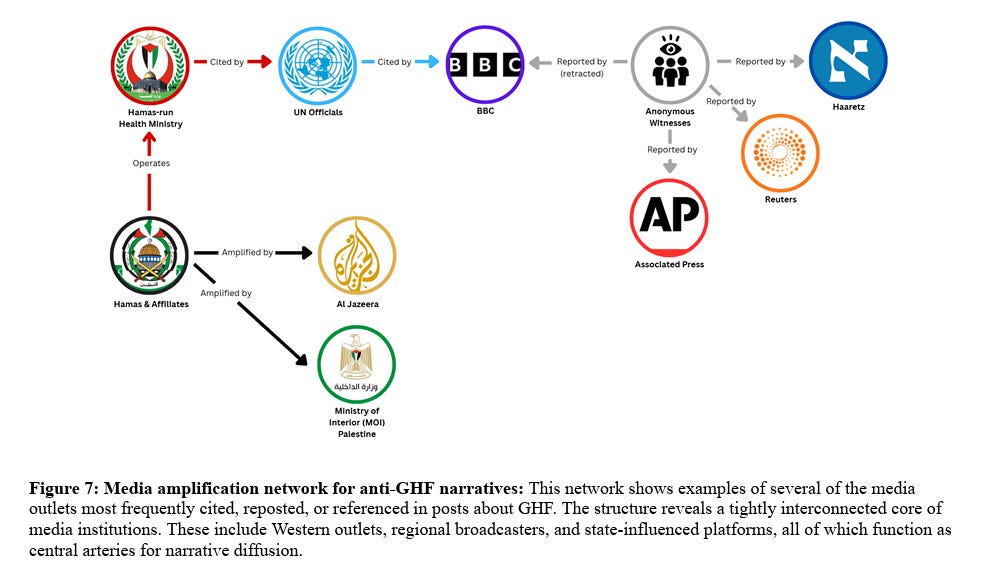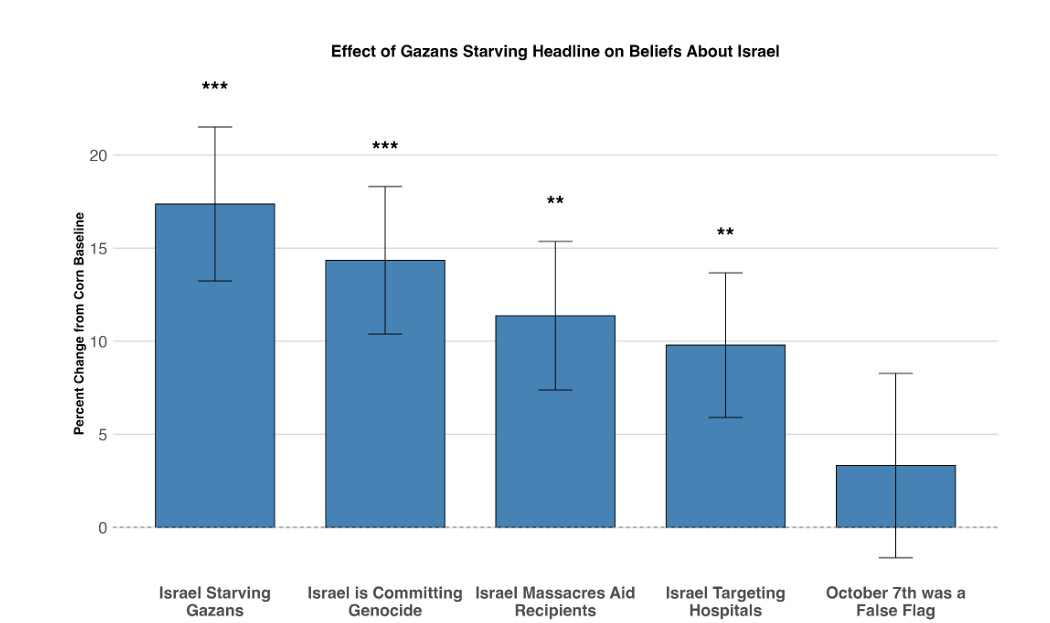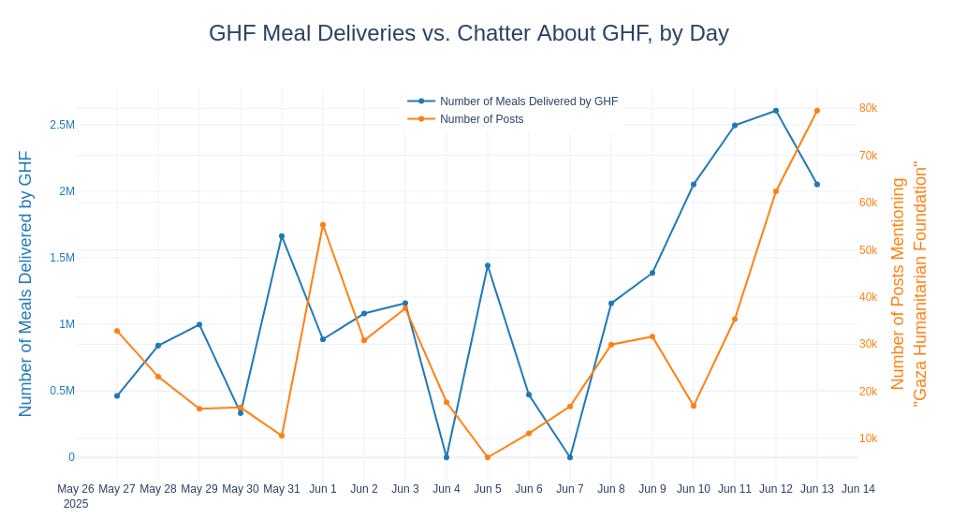The 4th Estate Sale: How Media Became Hamas's Megaphone
How Western media, activist networks, and hostile state actors converged to discredit a U.S.-led humanitarian effort—while shielding Hamas from scrutiny.
A new study by the Network Contagion Research Institute (NCRI) exposes how major U.S. and European media outlets amplified Hamas propaganda amid the 2025 Gaza humanitarian crisis. The U.S.-backed Gaza Humanitarian Foundation (GHF) delivered nearly 70 million meals to Gaza residents but faced relentless media attacks fueled by unverified claims sourced from Hamas-affiliated officials. These narratives, often repeated without disclosing the sources’ terrorist affiliations, shifted blame away from Hamas and toward U.S. and Israeli actors.
Mainstream outlets, NGOs, and social media personalities circulated unverified allegations—frequently citing the Hamas-run Gaza Health Ministry—as if it were neutral. Despite video evidence and reports from Palestinian sources unaffiliated with Hamas pointing to Hamas attacks on civilians, these facts were often ignored or buried. Headlines consistently blamed the IDF or GHF for alleged atrocities, while not a single one held Hamas responsible. Nearly 75% of major headlines failed to disclose the Hamas affiliation of their sources.
The study found that these misleading narratives were amplified by Kremlin-aligned media, Iranian influence networks, and conspiratorial actors across the political spectrum. False claims, such as a viral drug-trafficking conspiracy involving GHF, reached nearly 30 million people. Analysis showed that exposure to such media coverage significantly reduced public trust in U.S. aid efforts, with backlash intensifying in response to GHF’s successful meal deliveries. NGOs and UN-linked agencies with stakes in alternative aid pipelines frequently sidelined U.S. and Israeli accounts while promoting Hamas-sourced atrocity claims.
Several major news outlets later retracted or corrected key stories that falsely implicated Israel or GHF in atrocities. The Washington Post withdrew a headline claiming Israeli troops killed over 30 Palestinians near a U.S. aid site after relying solely on Hamas-run sources without disclosing affiliations. Reuters retracted an inaccurate claim linking GHF to controversial “camp” proposals. CNN initially reported Israeli responsibility for a deadly shooting without independent verification or Israeli comment. MSNBC misattributed a fatal incident to a GHF site before issuing corrections—though misleading content remains online.
These early, unverified claims went viral long before corrections were issued. Their spread fueled conspiracy theories, including widely circulated but baseless allegations that GHF laced flour with narcotics. Despite a lack of evidence and implausibility, these narratives—originating from the Hamas-run Gaza Media Office—were amplified by major outlets and social media influencers, turning humanitarian success into public suspicion.
The backlash also involved a deceptive online faction known as the “Fake MAGA” network. Though posing as pro-Trump “America First” voices, this group has a history of amplifying Kremlin and Iranian narratives, including bizarre anti-Trump conspiracies. Researchers found these actors spreading false claims about GHF and Gaza starvation, weaponizing emotionally charged misinformation to stoke domestic anger and radicalize followers. Powered by bots and engagement farms, they helped push dangerous narratives into the mainstream.
Daily posts about GHF surged by 946%, averaging 32 per day during peak periods. Sentiment analysis revealed that nearly half of all posts expressed negative views—almost twice as many as positive ones—and these negative posts generated 60% to 80% of total engagement. Negative chatter spiked in waves, closely tracking high-profile headlines accusing the IDF and GHF of harming civilians. A tightly linked network of outlets, often citing Hamas-run or anonymous sources, amplified these stories repeatedly.
Using AI to simulate public response, the study found that exposure to selected media stories reduced support for U.S.-led humanitarian aid by 38% and sharply decreased trust in U.S. and Israeli sources, while trust in Hamas-linked Gaza Health Ministry declined only slightly. Before exposure, blame for violence and aid failures was largely assigned to Hamas; afterward, blame shifted dramatically toward American aid groups and Israel—a 70% reduction in Hamas culpability. This reveals how media coverage systematically undermines Western-aligned actors while shielding Hamas-affiliated sources.
Research demonstrates that emotionally charged false claims—such as a retracted headline alleging 14,000 Gazan children would die of starvation—deeply distort moral perceptions and fuel extremist beliefs. An experimental study found that exposure to such misinformation increased agreement with conspiracy-like narratives portraying Israel as genocidal and intentionally targeting civilians. These narratives go beyond policy critique, dehumanizing Israel and simplifying complex conflicts into black-and-white moral battles. This distortion facilitates radicalization and justifies violence.
Strikingly, successful food deliveries by GHF triggered spikes in negative social media chatter with a three-day lag, suggesting that adversarial actors—including UN affiliates, NGOs, and media influencers—intensify attacks precisely when GHF succeeds. For these actors, GHF’s operational effectiveness threatens political and ideological narratives that depend on ongoing crisis and instability in Gaza.
What began as humanitarian aid was reframed as genocide—because it bypassed Hamas and succeeded. This is not journalism; it is narrative laundering with deadly consequences.

















This is enabled by a few scholars with substantial influence and authority, whose academic interests are enhanced by self appointed expertise on Israeli affairs, even though they are not in Israel. They need to be confronted on the limitations of their opinions and the present dangers in which they place Jews & Israel supporters all over the world.
O
Hello there